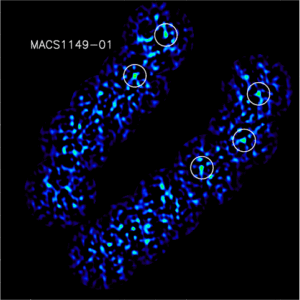The IRAM Lensing Survey: Probing Galaxy Formation in the Early Universe

Plateau de Bure Interferometer mosaic-images in the 1.2mm continuum (243 GHz) of the critical lines regions of five lensing galaxy clusters. Credit Kneib, Knudsen and Neri.
The IRAM Lensing Survey is a Large Program that used the IRAM PdB Interferometer and the WIDEX instrument to produce 1.3mm continuum map of the core of five massive lensing clusters. This is an international collaboration led by Jean-Paul Kneib (formerly at LAM, now at EPFL) Kirsten Knudsen (Chalmers) and Johan Richard (CRAL).
In each of the five clusters a number of overlapping PdB pointing followed the critical region where the amplification produced by the cluster exceed a factor of 10x (for sources at redshift larger than 5). Because of the magnification of the clusters, and the steep number counts of 1.3mm galaxies, the expectation is that looking at magnified region, we should detect typically about two times the number of sources compared to blank field regions.
The clusters targeted are five Northern Hemisphere Clusters, namely: A1703, MS1358, A2218, MACSJ0717, and MACSJ1149. The two MACS clusters have been observed as part of the Hubble Frontier Fields, public multi-wavelength and lens models can be found here. Lensing models for the other three clusters can be made available on request to Johan Richard.
The official Lensing Survey data repository is at IRAM. The link provides access to the baseline data products i.e. the calibrated data cubes and 1.3mm maps. The README file provides a detailed description of the data release.
Please do not hesitate to contact Jean-Paul Kneib and Kirsten Knudsen to tell them about your use of the data for scientific analysis.

